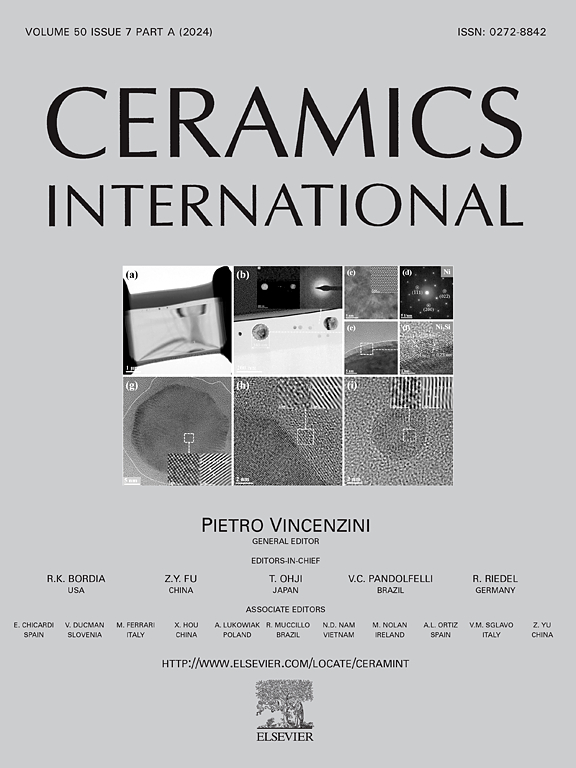Al3+共掺杂可使α-方石石中间隙态Eu2+的蓝色发光变宽并增强,用于高显色白光led
IF 5.1
2区 材料科学
Q1 MATERIALS SCIENCE, CERAMICS
引用次数: 0
摘要
有目的地在合适的寄主上产生间隙发光中心的间隙位点工程已经成为设计新型无机荧光粉的一种有趣的策略。然而,在这个阶段,有效地调节间质激活剂的光致发光仍然是一个艰巨的挑战。在这里,我们证明了无机荧光粉中间隙发光的有效调制。通过Al3+对Si4+的部分共价取代,掺有Eu2+的α-方石石(SiO2:Eu2+)的蓝色发射带(λem = 446 nm)得到了极大的增强和展宽。在SiO2晶格中引入Al3+离子后,蓝色发射带的半峰全宽度从59 nm增加到76 nm,量子效率提高了三倍(10.82%→35.56%)。此外,该材料的热稳定性显著提高,在325°C时(SiO2:0.06Al3+,0.005Eu2+)的发射保留率高达60%,远高于母材SiO2:0.005Eu2+的30%。在紫外LED芯片(λem = 375 nm)上封装蓝色发光SiO2:Al3+,Eu2+以及两种商用绿色和红色荧光粉,可获得高显色指数(Ra >;90)被成功地制造出来,显示出这种荧光粉在实现高质量白光LED照明方面的巨大潜力。该研究不仅提供了一种很有前途的蓝色发射体,而且为无机荧光粉的调制间隙发光特性提供了线索。本文章由计算机程序翻译,如有差异,请以英文原文为准。
Broadened and enhanced blue emission of interstitial Eu2+ in α-cristobalite via Al3+ codoping for high color rendering white LEDs
The interstitial site engineering that purposely creates interstitial luminescent centers in suitable hosts has become an intriguing strategy in designing novel inorganic phosphors. However, effectively tuning the photoluminescence of interstitial activators remains tough challenging at this stage. Here, we demonstrate the effective modulation of interstitial luminescence in inorganic phosphor. In detail, the blue emission band (λem = 446 nm) of interstitial Eu2+ doped α-cristobalite (SiO2:Eu2+) is largely enhanced and broadened via a partial, aliovalent substitution of Si4+ by Al3+. After introducing Al3+ ions into SiO2 lattice, the full width at half maximum of the blue emission band increase from 59 to 76 nm with a triple growth in quantum efficiency (10.82% → 35.56%). Moreover, the thermal stability improves significantly with a high emission retention of 60% at 325 °C (SiO2:0.06Al3+,0.005Eu2+), far higher than that of the parent SiO2:0.005Eu2+ (30%). Encapsulating blue-emitting SiO2:Al3+,Eu2+ along with two commercial green and red phosphors on an ultraviolet LED chip (λem = 375 nm), a white LED device with high color rendering index (Ra > 90) was successful fabricated, showing the great potential of this phosphor for achieving high-quality white LED lighting. This study not only provides a promising bule emitter but also sheds light on modulating interstitial luminescence properties in inorganic phosphors.
求助全文
通过发布文献求助,成功后即可免费获取论文全文。
去求助
来源期刊

Ceramics International
工程技术-材料科学:硅酸盐
CiteScore
9.40
自引率
15.40%
发文量
4558
审稿时长
25 days
期刊介绍:
Ceramics International covers the science of advanced ceramic materials. The journal encourages contributions that demonstrate how an understanding of the basic chemical and physical phenomena may direct materials design and stimulate ideas for new or improved processing techniques, in order to obtain materials with desired structural features and properties.
Ceramics International covers oxide and non-oxide ceramics, functional glasses, glass ceramics, amorphous inorganic non-metallic materials (and their combinations with metal and organic materials), in the form of particulates, dense or porous bodies, thin/thick films and laminated, graded and composite structures. Process related topics such as ceramic-ceramic joints or joining ceramics with dissimilar materials, as well as surface finishing and conditioning are also covered. Besides traditional processing techniques, manufacturing routes of interest include innovative procedures benefiting from externally applied stresses, electromagnetic fields and energetic beams, as well as top-down and self-assembly nanotechnology approaches. In addition, the journal welcomes submissions on bio-inspired and bio-enabled materials designs, experimentally validated multi scale modelling and simulation for materials design, and the use of the most advanced chemical and physical characterization techniques of structure, properties and behaviour.
Technologically relevant low-dimensional systems are a particular focus of Ceramics International. These include 0, 1 and 2-D nanomaterials (also covering CNTs, graphene and related materials, and diamond-like carbons), their nanocomposites, as well as nano-hybrids and hierarchical multifunctional nanostructures that might integrate molecular, biological and electronic components.
 求助内容:
求助内容: 应助结果提醒方式:
应助结果提醒方式:


